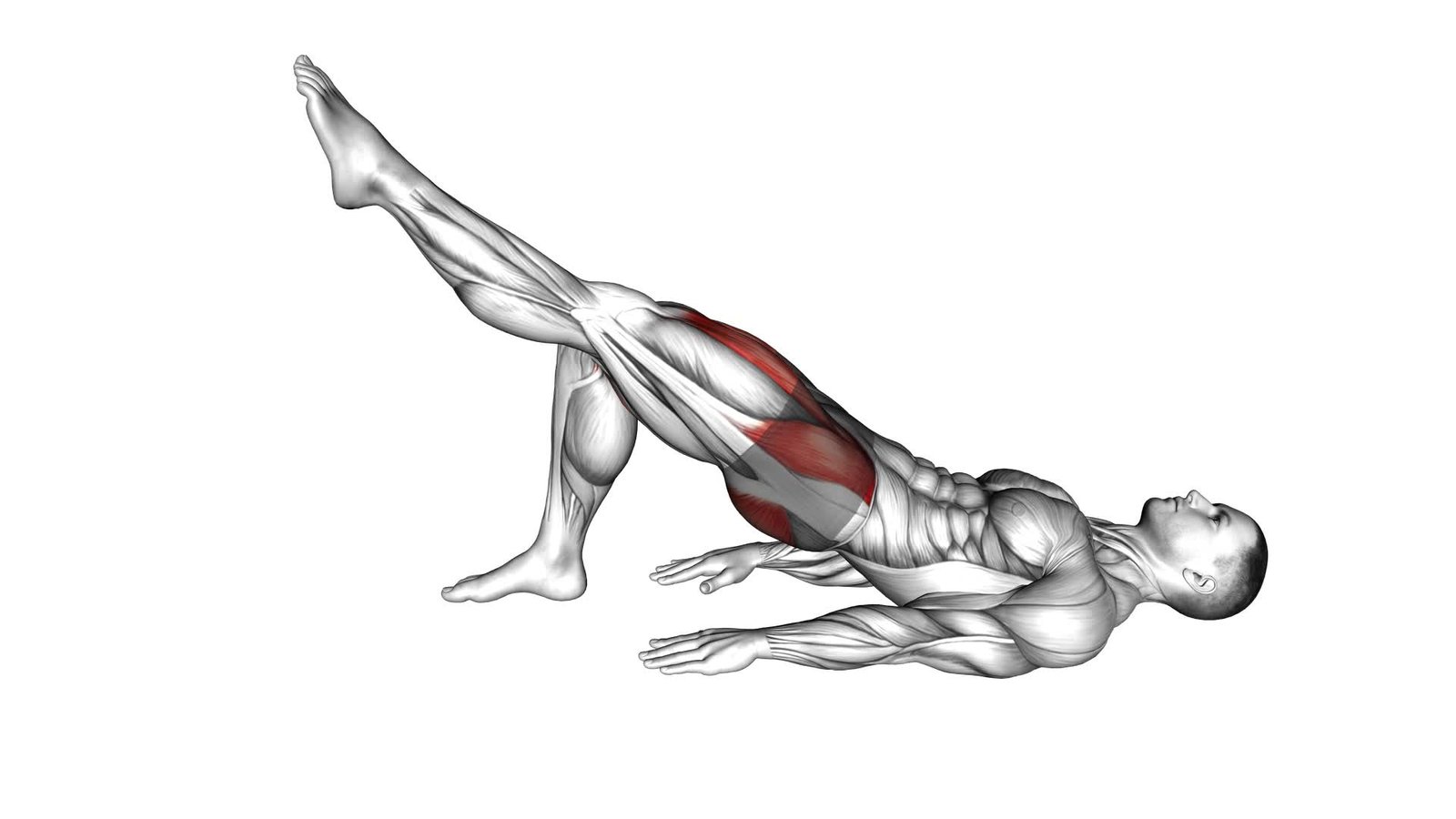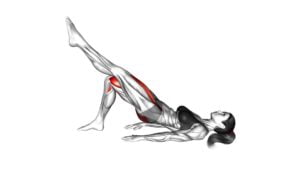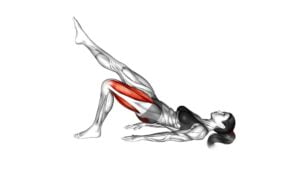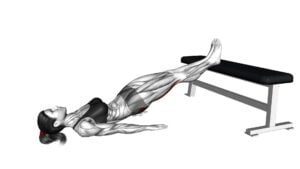Single Straight Leg Glute Bridge Hold (male) – Video Exercise Guide & Tips

Are you looking to strengthen your glutes and improve your lower body stability? Then the Single Straight Leg Glute Bridge Hold is the exercise for you.
Watch This Exercise Video
In this video exercise guide, we'll show you the proper form and technique to maximize your results.
You'll also learn advanced variations to challenge yourself and common mistakes to avoid.
Get ready to take your glute training to the next level with this effective exercise.
Let's get started!
Key Takeaways
- The Single Straight Leg Glute Bridge Hold is beneficial for strengthening glute muscles and improving hip stability.
- It targets the gluteus maximus, medius, and minimus muscles, enhancing athletic performance and preventing knee valgus and hip impingement.
- Proper form and technique include maintaining a neutral spine, engaging the core, and fully extending the hips.
- Advanced variations can challenge the glutes and hamstrings, such as using a resistance band, weighted plate, or medicine ball.
Benefits of the Single Straight Leg Glute Bridge Hold
You should regularly incorporate the Single Straight Leg Glute Bridge Hold into your workout routine for maximum glute activation. This exercise is highly effective in strengthening the glute muscles and improving hip stability.
By targeting the gluteus maximus, gluteus medius, and gluteus minimus, the Single Straight Leg Glute Bridge Hold helps to develop and tone these important muscles in your posterior chain.
The gluteus maximus, being the largest muscle in your body, plays a crucial role in hip extension, which is essential for movements such as running, jumping, and squatting. By regularly engaging and strengthening this muscle, you can enhance your athletic performance and overall power output.
Additionally, the gluteus medius and gluteus minimus are responsible for hip abduction and internal rotation. By focusing on these muscles during the Single Straight Leg Glute Bridge Hold, you can improve your hip stability and prevent common injuries, such as knee valgus and hip impingement.
To perform the exercise with proper form and technique, it's important to maintain a neutral spine, engage your core, and fully extend your hips. By following these guidelines, you can optimize the benefits of the Single Straight Leg Glute Bridge Hold and take your glute training to the next level.
Proper Form and Technique for the Exercise
To perform the Single Straight Leg Glute Bridge Hold with proper form and technique, it's essential to maintain a neutral spine, engage your core, and fully extend your hips. This exercise primarily targets the gluteus maximus, but also activates the hamstrings and lower back muscles.
A common misconception is that this exercise only benefits advanced individuals. However, there are variations that beginners can try to build strength and stability before progressing. One variation is to perform the exercise with both feet on the ground, lifting the hips as high as possible while maintaining the neutral spine position. This allows beginners to focus on proper form and gradually increase their strength.
To begin the Single Straight Leg Glute Bridge Hold, lie on your back with your knees bent and feet flat on the ground. Extend one leg straight out in front of you, keeping the foot flexed. Press through the heel of the opposite foot and lift your hips off the ground until your body forms a straight line from your knees to your shoulders. Hold this position for the desired amount of time, usually 10-30 seconds, while maintaining a neutral spine and engaging your core.
Remember to breathe throughout the exercise and avoid arching your lower back. By practicing proper form and technique, you can maximize the benefits of the Single Straight Leg Glute Bridge Hold and avoid unnecessary strain on your muscles and joints.
Advanced Variations to Challenge Yourself
To challenge yourself further, try incorporating advanced variations of the Single Straight Leg Glute Bridge Hold exercise. These advanced progressions won't only increase the difficulty of the exercise but also target your glutes and hamstrings in new and challenging ways.
One advanced variation you can try is the Single Straight Leg Glute Bridge Hold with a Resistance Band. This involves placing a resistance band just above your knees and performing the exercise as usual. The resistance band adds extra tension to your glutes and requires more stability to maintain the hold.
Another alternative exercise is the Single Straight Leg Glute Bridge Hold with a Weighted Plate. By placing a weighted plate on your hips while performing the exercise, you increase the load on your glutes and make the exercise more challenging.
You can also try the Single Straight Leg Glute Bridge Hold with a Medicine Ball. This variation involves holding a medicine ball between your knees while performing the exercise. This adds an element of instability and requires more control to maintain the hold.
Incorporating these advanced variations into your workout routine will help you continually challenge your glutes and hamstrings, leading to greater strength and muscle development. Remember to always maintain proper form and technique to prevent injury.
Common Mistakes to Avoid
To avoid making common mistakes, ensure that you maintain proper form and technique during the Single Straight Leg Glute Bridge Hold exercise. One of the most common mistakes people make is allowing their hips to sag or drop during the exercise. This not only reduces the effectiveness of the exercise but also puts unnecessary strain on your lower back. To avoid this, focus on keeping your hips lifted and in line with your knees and shoulders throughout the entire movement.
Another common mistake isn't fully engaging the glutes during the exercise. To properly activate your glute muscles, be sure to squeeze your glutes as you lift your hips off the ground and hold the position. This will help you maximize the benefits of the exercise and prevent other muscles from compensating.
Furthermore, improper foot placement can also lead to mistakes. Make sure your foot is positioned directly under your knee and that your toes are pointing forward. This will ensure that you're properly engaging the muscles in your glutes and prevent strain on other joints.
Tips for Incorporating the Exercise Into Your Routine
To maximize the effectiveness of your Single Straight Leg Glute Bridge Hold exercise, incorporate it into your routine by focusing on consistency and progression. Here are some tips to help you incorporate this exercise into your fitness routine:
- Progression options for the single straight leg glute bridge hold:
- Increase the hold time: Start with a 10-second hold and gradually increase it to 30 seconds or more as you build strength.
- Add resistance: Place a weight plate or a resistance band just above your knees to add resistance and make the exercise more challenging.
- Elevate your feet: Place your feet on an elevated surface, such as a step or a bench, to increase the range of motion and engage your glutes and hamstrings even more.
- How to modify the exercise for different fitness levels:
- Beginner modification: If you're new to this exercise or find it difficult to maintain balance, you can perform the glute bridge hold with both feet on the ground instead of using a single straight leg.
- Intermediate modification: Use a stability ball under your feet instead of a bench or step to increase the instability and engage your core muscles.
- Advanced modification: Perform the exercise with your arms extended overhead to challenge your core and improve your stability.
By incorporating these tips into your routine, you can ensure that you're progressing in your fitness journey and getting the most out of the Single Straight Leg Glute Bridge Hold exercise. Remember to listen to your body and adjust the intensity as needed.
Happy exercising!
Frequently Asked Questions
How Many Repetitions Should I Do for the Single Straight Leg Glute Bridge Hold?
For the single straight leg glute bridge hold, the number of repetitions can vary depending on your fitness level and goals. It's recommended to start with 8-10 reps per set and gradually increase as you get stronger.
Incorporating this exercise into your workout routine can provide numerous benefits, such as targeting the glutes and improving hip stability.
To perform it correctly, make sure to maintain proper form and technique, keeping your core engaged and hips lifted throughout the movement.
What Are Some Alternative Exercises That Target the Same Muscle Group?
To target your glutes without using weights, there are a few exercises you can try.
One option is the bodyweight glute bridge, where you raise your hips off the ground while keeping your feet flat.
Another alternative is the hip thrust, where you place your upper back on a bench and lift your hips up.
For beginners, you can modify the glute bridge hold by bending your knees or using a resistance band for assistance.
Can Women Also Perform the Single Straight Leg Glute Bridge Hold?
Yes, women can definitely perform the single straight leg glute bridge hold.
It's a beneficial exercise for women's strength training as it specifically targets the glute muscles.
Glute exercises, like the single straight leg glute bridge hold, can help women improve their lower body strength, enhance their athletic performance, and build a toned and sculpted appearance.
Incorporating glute exercises into a women's strength training routine can lead to numerous benefits for overall fitness and body composition.
How Long Should I Hold the Bridge Position for Maximum Benefits?
To maximize the benefits of holding the bridge position, it's important to maintain proper form and engage your glute muscles.
The duration of the hold will depend on your fitness level and goals. Start with 10-15 seconds and gradually increase the time as you get stronger.
Remember, there are variations of glute bridge exercises that can target different muscle groups and add variety to your workouts.
Consult a fitness professional for personalized guidance.
Does the Single Straight Leg Glute Bridge Hold Help With Improving Posture?
The single straight leg glute bridge hold is an effective exercise for improving posture. By engaging your glutes during this exercise, you can strengthen the muscles that support proper alignment and stability in your spine. This can lead to improved posture and reduced risk of back pain.
Athletes can benefit from this exercise as it helps to enhance their overall performance and prevent injuries. Make sure to properly engage your glutes by squeezing them throughout the movement for maximum benefits.
Conclusion
Incorporating the single straight leg glute bridge hold into your exercise routine can provide numerous benefits. This exercise is great for strengthening your glute muscles and improving hip stability. It's important to maintain proper form and technique while performing the exercise to maximize its effectiveness. Additionally, challenging yourself with advanced variations can help take your workout to the next level. To get the most out of this exercise, it's important to avoid common mistakes and follow the tips provided. By starting to incorporate the single straight leg glute bridge hold into your routine today, you can look forward to stronger glutes and improved overall fitness.

Author
Years ago, the spark of my life’s passion ignited in my mind the moment I stepped into the local gym for the first time. The inaugural bead of perspiration, the initial endeavor, the very first surge of endorphins, and a sense of pride that washed over me post-workout marked the beginning of my deep-seated interest in strength sports, fitness, and sports nutrition. This very curiosity blossomed rapidly into a profound fascination, propelling me to earn a Master’s degree in Physical Education from the Academy of Physical Education in Krakow, followed by a Sports Manager diploma from the Jagiellonian University. My journey of growth led me to gain more specialized qualifications, such as being a certified personal trainer with a focus on sports dietetics, a lifeguard, and an instructor for wellness and corrective gymnastics. Theoretical knowledge paired seamlessly with practical experience, reinforcing my belief that the transformation of individuals under my guidance was also a reflection of my personal growth. This belief holds true even today. Each day, I strive to push the boundaries and explore new realms. These realms gently elevate me to greater heights. The unique combination of passion for my field and the continuous quest for growth fuels my drive to break new ground.







